2002 BMW 325I brake
[x] Cancel search: brakePage 4 of 155

Contents
© 2001 Bayerische Motoren Werke
Aktiengesellschaft
Munich, Germany
Reprinting, including excerpts, only with the
written consent of BMW AG, Munich.
Order No. 01 41 0 156 156
US English VIII/01
Printed in Germany
Printed on environmentally friendly paper
(bleached without chlorine, suitable for recycling).
Overview
Controls and features
Cockpit14
Instrument cluster15
Indicator and warning lamps17
Multifunction steering wheel
(MFL)21
Hazard warning triangle22
Refueling22
Fuel specifications23
Tire inflation pressures24
Opening and closing:
Keys28
Central locking system28
Opening and closing Ð via the
remote control29
Opening and closing Ð via the
door lock31
Opening and closing Ð from the
inside32
Tailgate33
Rear window34
Cargo area35
Alarm system35
Electric power windows37
Sliding/tilt sunroof38
Adjustments:
Correct sitting posture40
Seats40
Manual seat adjustment41
Power seat adjustment42
Lumbar support42
Head restraints43
Safety belts44
Seat and mirror memory45
Seat heating46
Steering wheel46
Mirrors47
Passenger safety systems:
Airbags48
Transporting children safely51Vehicle Memory, Key
Memory54
Driving:
Ignition lock55
Starting the engine55
Switching off the engine56
Parking brake57
Manual transmission57
Automatic transmission with
Steptronic58
Indicator/Headlamp flasher60
Washer/Wiper system/Rain
sensor61
Cruise control63
Everything under control:
Odometer65
Tachometer65
Energy control65
Fuel gauge66
Coolant temperature gauge66
Service Interval Display66
Check Control67
Clock67
Computer68
Technology for safety and
driving convenience:
Park Distance Control (PDC)70
Automatic Stability Control plus
Traction (ASC+T)71
Dynamic Stability Control
(DSC)73
Contents
Page 5 of 155
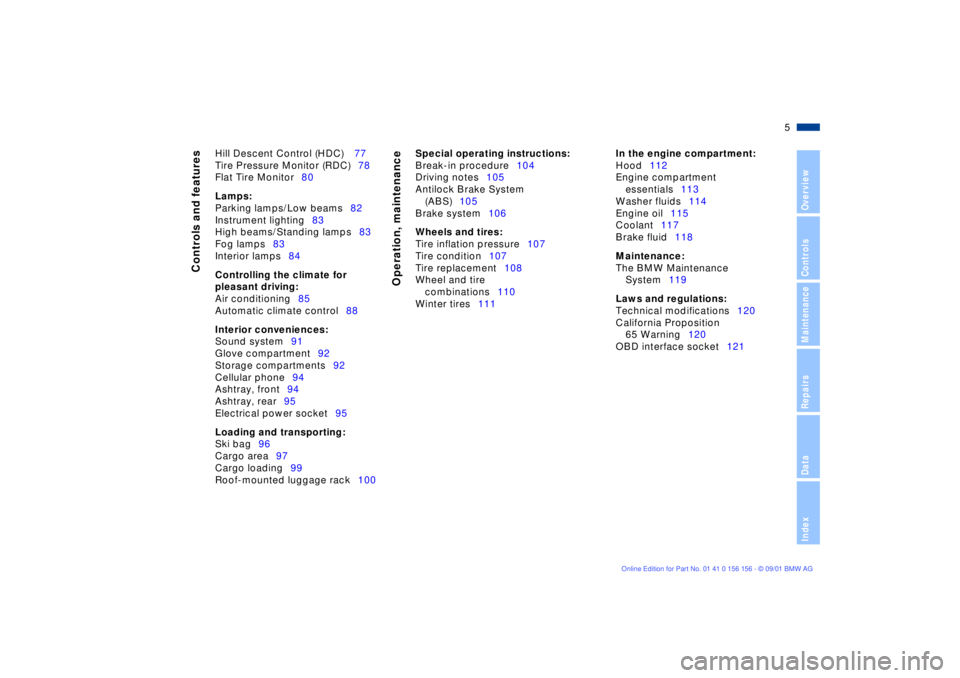
5n
OverviewControlsMaintenanceRepairsDataIndex
Controls and features
Operation, maintenance
Hill Descent Control (HDC) 77
Tire Pressure Monitor (RDC)78
Flat Tire Monitor80
Lamps:
Parking lamps/Low beams82
Instrument lighting83
High beams/Standing lamps83
Fog lamps83
Interior lamps84
Controlling the climate for
pleasant driving:
Air conditioning85
Automatic climate control88
Interior conveniences:
Sound system91
Glove compartment92
Storage compartments92
Cellular phone94
Ashtray, front94
Ashtray, rear95
Electrical power socket95
Loading and transporting:
Ski bag96
Cargo area97
Cargo loading99
Roof-mounted luggage rack100
Special operating instructions:
Break-in procedure104
Driving notes105
Antilock Brake System
(ABS)105
Brake system106
Wheels and tires:
Tire inflation pressure107
Tire condition107
Tire replacement108
Wheel and tire
combinations110
Winter tires111
In the engine compartment:
Hood112
Engine compartment
essentials113
Washer fluids114
Engine oil115
Coolant117
Brake fluid118
Maintenance:
The BMW Maintenance
System119
Laws and regulations:
Technical modifications120
California Proposition
65 Warning120
OBD interface socket121
Page 10 of 155

10n
For your own safety
Use unleaded gasoline only. Fuels
containing up to and including
10 % ethanol or other oxygenates with
up to 2.8 % oxygen by weight (i.e.
15 % MTBE or 3 % methanol plus an
equivalent amount of co-solvent) will
not void the applicable warranties
respecting defects in materials or work-
manship. Field experience has indi-
cated significant differences in fuel
quality (volatility, composition, addi-
tives, for example) among gasolines
offered for sale in the United States and
Canada. The use of poor-quality fuels
may result in driveability, starting and
stalling problems especially under
certain environmental conditions, such
as high ambient temperature and high
altitude.
Should you encounter driveability prob-
lems which you suspect could be
related to the fuel you are using, we
recommend that you respond by
switching to a recognized high-quality
brand.
Failure to comply with these recom-
mendations may result in unscheduled
maintenance.
Obey all applicable safety rules when
you are handling gasoline.
<
Important safety information!
For your own safety, use genuine parts
and accessories approved by BMW.
When you purchase accessories tested
and approved by BMW and Original
BMW Parts, you simultaneously acquire
the assurance that they have been
thoroughly tested by BMW to ensure
optimum performance when installed
on your vehicle.
BMW warrants these parts to be free
from defects in material and workman-
ship.
BMW will not accept any liability for
damage resulting from installation of
parts and accessories not approved by
BMW.
BMW cannot test every product made
by other manufacturers to ascertain
whether it can be used on a BMW
safely and without risk to either the
vehicle, its operation, or its occupants.
Original BMW Parts, BMW Accessories
and other products approved by BMW,
together with professional advice on
using these items, are available from all
BMW centers.
Installation and operation of non-BMW
approved accessories such as alarms,
radios, amplifiers, radar detectors,
wheels, suspension components, brake
dust shields, telephones (including
operation of any portable cellular phone
from within the vehicle without using an
externally mounted antenna) or trans-
ceiver equipment (such as CB, walkie-
talkie, ham radio or similar) may cause
extensive damage to the vehicle,
compromise its safety, interfere with
the vehicle's electrical system or affect
the validity of the BMW Limited
Warranty. Contact your BMW center for
additional information.
Do not use key or remote control to
lock doors or cargo area with anyone
inside the vehicle. Refer to pages 29
and 32 for more details.
<
Maintenance, replacement, or
repair of the emission control
devices and systems may be performed
by any automotive repair establishment
or individual using any certified auto-
motive part.
<
Symbol on vehicle parts
Indicates that you should consult
the relevant section of this
Owner's Manual for information on a
particular part or assembly.
Page 17 of 155
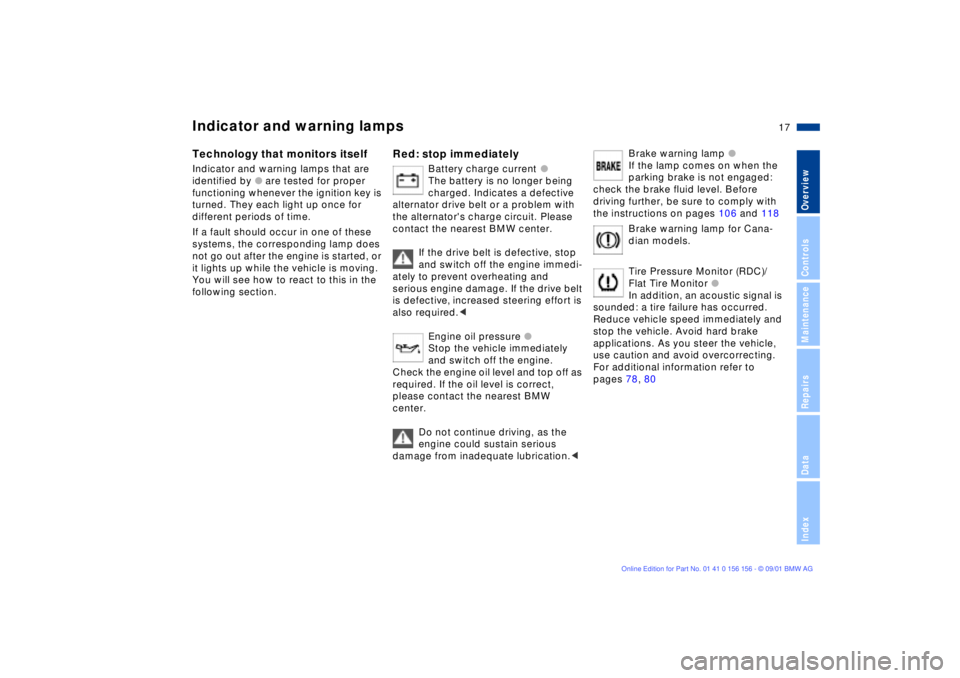
17n
OverviewControlsMaintenanceRepairsDataIndex
Indicator and warning lamps
Technology that monitors itself
Indicator and warning lamps that are
identified by
l
are tested for proper
functioning whenever the ignition key is
turned. They each light up once for
different periods of time.
If a fault should occur in one of these
systems, the corresponding lamp does
not go out after the engine is started, or
it lights up while the vehicle is moving.
You will see how to react to this in the
following section.
Red: stop immediately
Battery charge current
l
The battery is no longer being
charged. Indicates a defective
alternator drive belt or a problem with
the alternator's charge circuit. Please
contact the nearest BMW center.
If the drive belt is defective, stop
and switch off the engine immedi-
ately to prevent overheating and
serious engine damage. If the drive belt
is defective, increased steering effort is
also required.
<
Engine oil pressure
l
Stop the vehicle immediately
and switch off the engine.
Check the engine oil level and top off as
required. If the oil level is correct,
please contact the nearest BMW
center.
Do not continue driving, as the
engine could sustain serious
damage from inadequate lubrication.
<
Brake warning lamp
l
If the lamp comes on when the
parking brake is not engaged:
check the brake fluid level. Before
driving further, be sure to comply with
the instructions on pages 106 and 118
Brake warning lamp for Cana-
dian models.
Tire Pressure Monitor (RDC)/
Flat Tire Monitor
l
In addition, an acoustic signal is
sounded: a tire failure has occurred.
Reduce vehicle speed immediately and
stop the vehicle. Avoid hard brake
applications. As you steer the vehicle,
use caution and avoid overcorrecting.
For additional information refer to
pages 78, 80
Page 18 of 155
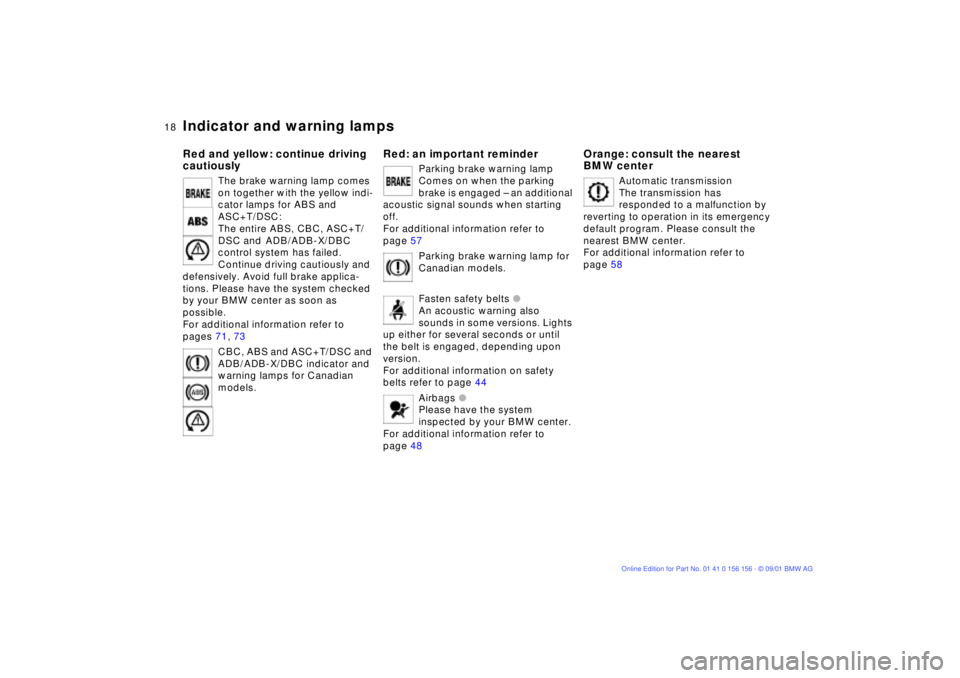
18n
Indicator and warning lamps
Red and yellow: continue driving
cautiously
The brake warning lamp comes
on together with the yellow indi-
cator lamps for ABS and
ASC+T/DSC:
The entire ABS, CBC, ASC+T/
DSC and
ADB/ADB-X/DBC
control system has failed.
Continue driving cautiously and
defensively. Avoid full brake applica-
tions. Please have the system checked
by your BMW center as soon as
possible.
For additional information refer to
pages 71, 73
CBC, ABS and ASC+T/DSC and
ADB/ADB-X/DBC indicator and
warning lamps for Canadian
models.
Red: an important reminder
Parking brake warning lamp
Comes on when the parking
brake is engaged Ð an additional
acoustic signal sounds when starting
off.
For additional information refer to
page 57
Parking brake warning lamp for
Canadian models.
Fasten safety belts
l
An acoustic warning also
sounds in some versions. Lights
up either for several seconds or until
the belt is engaged, depending upon
version.
For additional information on safety
belts refer to page 44
Airbags
l
Please have the system
inspected by your BMW center.
For additional information refer to
page 48
Orange: consult the nearest
BMW center
Automatic transmission
The transmission has
responded to a malfunction by
reverting to operation in its emergency
default program. Please consult the
nearest BMW center.
For additional information refer to
page 58
Page 19 of 155
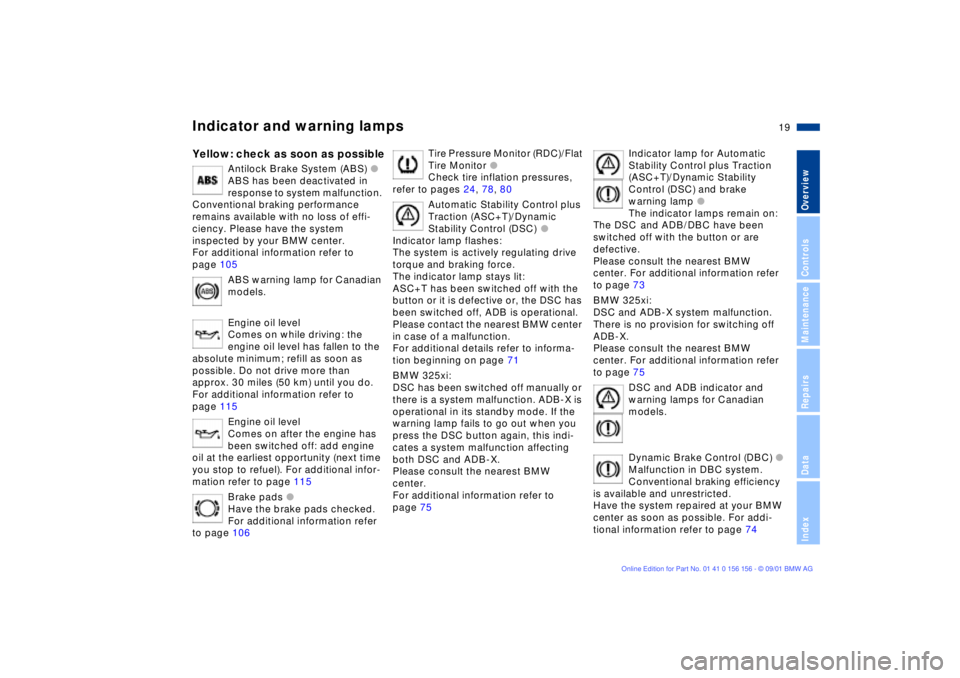
19n
OverviewControlsMaintenanceRepairsDataIndex
Indicator and warning lamps
Yellow: check as soon as possible
Antilock Brake System (ABS)
l
ABS has been deactivated in
response to system malfunction.
Conventional braking performance
remains available with no loss of effi-
ciency. Please have the system
inspected by your BMW center.
For additional information refer to
page 105
ABS warning lamp for Canadian
models.
Engine oil level
Comes on while driving: the
engine oil level has fallen to the
absolute minimum; refill as soon as
possible. Do not drive more than
approx. 30 miles (50 km) until you do.
For additional information refer to
page 115
Engine oil level
Comes on after the engine has
been switched off: add engine
oil at the earliest opportunity (next time
you stop to refuel). For additional infor-
mation refer to page 115
Brake pads
l
Have the brake pads checked.
For additional information refer
to page 106
Tire Pressure Monitor (RDC)/Flat
Tire Monitor
l
Check tire inflation pressures,
refer to pages 24, 78, 80
Automatic Stability Control plus
Traction (ASC+T)/Dynamic
Stability Control (DSC)
l
Indicator lamp flashes:
The system is actively regulating drive
torque and braking force.
The indicator lamp stays lit:
ASC+T has been switched off with the
button or it is defective or, the DSC has
been switched off, ADB is operational.
Please contact the nearest BMW center
in case of a malfunction.
For additional details refer to informa-
tion beginning on page 71
BMW 325xi:
DSC has been switched off manually or
there is a system malfunction. ADB-X is
operational in its standby mode. If the
warning lamp fails to go out when you
press the DSC button again, this indi-
cates a system malfunction affecting
both DSC and ADB-X.
Please consult the nearest BMW
center.
For additional information refer to
page 75
Indicator lamp for Automatic
Stability Control plus Traction
(ASC+T)/Dynamic Stability
Control (DSC) and brake
warning lamp
l
The indicator lamps remain on:
The DSC
and ADB/DBC have been
switched off with the button or are
defective.
Please consult the nearest BMW
center. For additional information refer
to page 73
BMW 325xi:
DSC and ADB-X system malfunction.
There is no provision for switching off
ADB-X.
Please consult the nearest BMW
center. For additional information refer
to page 75
DSC and ADB indicator and
warning lamps for Canadian
models.
Dynamic Brake Control (DBC)
l
Malfunction in DBC system.
Conventional braking efficiency
is available and unrestricted.
Have the system repaired at your BMW
center as soon as possible. For addi-
tional information refer to page 74
Page 55 of 155
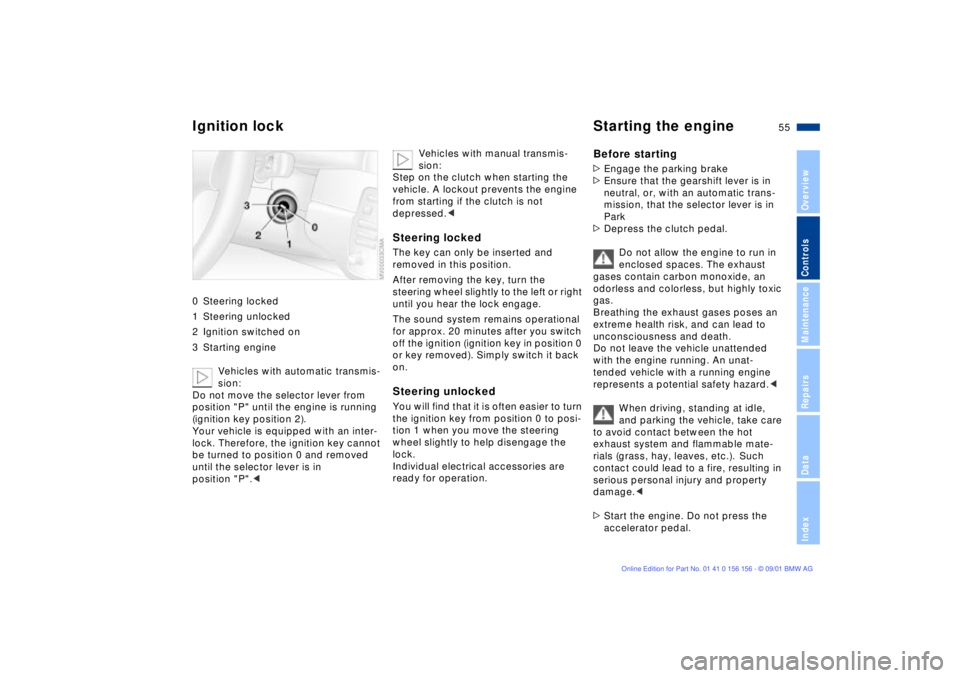
55n
OverviewControlsMaintenanceRepairsDataIndex
Ignition lock Starting the engine 0 Steering locked
1 Steering unlocked
2 Ignition switched on
3 Starting engine
Vehicles with automatic transmis-
sion:
Do not move the selector lever from
position "P" until the engine is running
(ignition key position 2).
Your vehicle is equipped with an inter-
lock. Therefore, the ignition key cannot
be turned to position 0 and removed
until the selector lever is in
position "P".<
Vehicles with manual transmis-
sion:
Step on the clutch when starting the
vehicle. A lockout prevents the engine
from starting if the clutch is not
depressed.<
Steering lockedThe key can only be inserted and
removed in this position.
After removing the key, turn the
steering wheel slightly to the left or right
until you hear the lock engage.
The sound system remains operational
for approx. 20 minutes after you switch
off the ignition (ignition key in position 0
or key removed). Simply switch it back
on.Steering unlocked You will find that it is often easier to turn
the ignition key from position 0 to posi-
tion 1 when you move the steering
wheel slightly to help disengage the
lock.
Individual electrical accessories are
ready for operation.
Before starting>Engage the parking brake
>Ensure that the gearshift lever is in
neutral, or, with an automatic trans-
mission, that the selector lever is in
Park
>Depress the clutch pedal.
Do not allow the engine to run in
enclosed spaces. The exhaust
gases contain carbon monoxide, an
odorless and colorless, but highly toxic
gas.
Breathing the exhaust gases poses an
extreme health risk, and can lead to
unconsciousness and death.
Do not leave the vehicle unattended
with the engine running. An unat-
tended vehicle with a running engine
represents a potential safety hazard.<
When driving, standing at idle,
and parking the vehicle, take care
to avoid contact between the hot
exhaust system and flammable mate-
rials (grass, hay, leaves, etc.). Such
contact could lead to a fire, resulting in
serious personal injury and property
damage.<
>Start the engine. Do not press the
accelerator pedal.
Page 56 of 155

56n
Starting the engine Switching off the engine
Do not actuate the starter for too
short a time, but do not actuate it
for more than approx. 20 seconds.
Release the ignition key immediately
when the engine starts.
Do not allow the engine to warm up by
leaving it running while the vehicle
remains stationary. Instead, drive off
immediately at a moderate engine
speed.<
If the engine does not start on the first
attempt (if it is very hot or cold, for
instance):
>Press the accelerator pedal halfway
down while engaging the starter.
Cold starts at extremely cold tempera-
tures of approx. +5 7 (Ð15 6) or below
and at high altitude over 3,300 ft
(1,000 m):
>On the first start attempt, engage the
starter for a longer period (approx.
10 seconds)
>Press the accelerator pedal halfway
down while engaging the starter.
The engine's idle speed is controlled by
the engine-management system. A high
idle after starting is normal and should
decrease as the engine warms up. If the
idle speed does not decrease, service
is required.
To prevent the battery from discharging,
always switch off electrical devices that
are not in use. Switch the ignition off
when the vehicle is not being driven.
Extended starting attempts, char-
acterized by excessively frequent
or long periods with the starter
engaged, can lead to damage to the
catalytic converter.<
Turn the ignition key to position 1 or 0.
You should never remove the igni-
tion key when the vehicle is in
motion, as the steering lock could
engage.
When you leave the vehicle, always
remove the ignition key and engage the
steering lock.
Vehicles with manual transmission:
Always engage the parking brake when
parking on hills and slopes, as first gear
or reverse may not provide adequate
resistance to rolling.
Vehicles with automatic transmission:
Place the selector lever in "Park".<